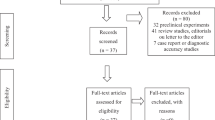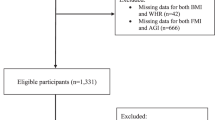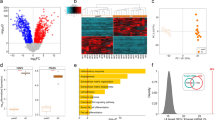Abstract
Background
Human Adenovirus D-36 (HAdV-D36) promotes adipogenesis in cellular and animal models and may contribute to the development of human obesity. Induction of PPARγ by HAdV-D36 seems to have a central role in the maintenance of adipogenic status. There is limited information about epigenetic mechanisms contributing to this process in human adipose tissue. This study evaluated the expression of lncRNAs (ADINR, GAS5 and MEG3) and miRNAs (miR-18a and miR-140) involved in the adipogenic process in visceral adipose tissue (VAT) of subjects with obesity with previous HAdV-D36 infection (seropositive) and unexposed (seronegative) subjects with obesity.
Methods
Individuals with obesity were grouped according to the presence of antibodies against HAdV-D36 (Seropositive: HAdV-D36[+], n = 29; and Seronegative: HAdV-D36[−], n = 28). Additionally, a group of individuals without obesity (n = 17) was selected as a control group. The HAdV-D36 serology was carried out by ELISA. Biopsies of VAT were obtained during an elective and clinically indicated surgery (bariatric or cholecystectomy). RNA extraction from VAT was performed and the expression of PPARG and non-coding RNAs was evaluated by qPCR.
Results
HAdV-D36[+] individuals had lower expression of anti-adipogenic lncRNAs GAS5 (p = 0.016) and MEG3 (p = 0.035) compared with HAdV-D36[-] subjects with obesity. HAdV-D36[+] subjects also presented increased expression of the adipogenic miRNA miR-18a (p = 0.042), which has been reported to be modulated by GAS5 through a RNA sponging mechanism during adipogenic differentiation. Additionally, an inverse correlation of GAS5 with PPARG expression was observed (r = −0.917, p = 0.01).
Conclusion
Our results suggest that HAdV-D36 is related to non-coding RNAs implicated in adipogenesis, representing a potential mechanism by which previous HAdV-D36 infection could be associated with the long-term maintenance of adipogenic status, probably through the GAS5/miR-18a axis.
This is a preview of subscription content, access via your institution
Access options
Subscribe to this journal
Receive 12 print issues and online access
$259.00 per year
only $21.58 per issue
Buy this article
- Purchase on SpringerLink
- Instant access to full article PDF
Prices may be subject to local taxes which are calculated during checkout





Similar content being viewed by others
Data availability
The datasets generated during and/or analyzed during the current study are available from the corresponding author on reasonable request.
References
Fang Y, Yan C, Zhao Q, Xu J, Liu Z, Gao J, et al. The roles of microbial products in the development of colorectal cancer: a review. Bioengineered. 2021;12:720–35.
Rizzetto L, Fava F, Tuohy KM, Selmi C. Connecting the immune system, systemic chronic inflammation and the gut microbiome: The role of sex. J Autoimmun. 2018;92:12–34.
Gammone MA, D’Orazio N. COVID-19 and Obesity: Overlapping of Two Pandemics. Obes Facts. 2021;14:579–85.
van Ginneken V, Sitnyakowsky L, Jeffery JE. Infectobesity: viral infections (especially with human adenovirus-36: Ad-36) may be a cause of obesity. Med Hypotheses. 2009;72:383–8.
Marjani A, Khatami A, Saadati H, Asghari M, Razizadeh MH, Abbasi A, et al. Association of adenovirus 36 infection and obesity; An updated meta-analysis of community-based studies. Rev Med Virol. 2022;32:e2255.
Akheruzzaman M, Hegde V, Dhurandhar NV. Twenty-five years of research about adipogenic adenoviruses: A systematic review. Obes Rev. 2019;20:499–509.
Xu MY, Cao B, Wang DF, Guo JH, Chen KL, Shi M, et al. Human Adenovirus 36 Infection Increased the Risk of Obesity: A Meta-Analysis Update. Medicine. 2015;94:e2357.
da Silva Fernandes J, Schuelter-Trevisol F, Cancelier ACL, Gonçalves E Silva HC, de Sousa DG, Atkinson RL, et al. Adenovirus 36 prevalence and association with human obesity: a systematic review. Int J Obes. 2021;45:1342–56.
Shastri AA, Hegde V, Peddibhotla S, Feizy Z, Dhurandhar NV. E4orf1: A protein for enhancing glucose uptake despite impaired proximal insulin signaling. PLoS One. 2018;13:e0208427.
Dhurandhar EJ, Krishnapuram R, Hegde V, Dubuisson O, Tao R, Dong XC, et al. E4orf1 improves lipid and glucose metabolism in hepatocytes: a template to improve steatosis & hyperglycemia. PLoS One. 2012;7:e47813.
Vangipuram SD, Yu M, Tian J, Stanhope KL, Pasarica M, Havel PJ, et al. Adipogenic human adenovirus-36 reduces leptin expression and secretion and increases glucose uptake by fat cells. Int J Obes. 2007;31:87–96.
Rogers PM, Fusinski KA, Rathod MA, Loiler SA, Pasarica M, Shaw MK, et al. Human adenovirus Ad-36 induces adipogenesis via its E4 orf-1 gene. Int J Obes. 2008;32:397–406.
Pasarica M, Shin AC, Yu M, Ou Yang HM, Rathod M, Jen KL, et al. Human adenovirus 36 induces adiposity, increases insulin sensitivity, and alters hypothalamic monoamines in rats. Obesity. 2006;14:1905–13.
Dhurandhar NV, Whigham LD, Abbott DH, Schultz-Darken NJ, Israel BA, Bradley SM, et al. Human adenovirus Ad-36 promotes weight gain in male rhesus and marmoset monkeys. J Nutr. 2002;132:3155–60.
Manriquez V, Gutierrez A, Morales A, Brito R, Pavez M, Sapunar J, et al. Influence of adenovirus 36 seropositivity on the expression of adipogenic microRNAs in obese subjects. Int J Obes. 2020;44:2303–12.
Knox J, Bou-Gharios G, Hamill KJ, Willoughby CE. MiR-18a-5p Targets Connective Tissue Growth Factor Expression and Inhibits Transforming Growth Factor β2-Induced Trabecular Meshwork Cell Contractility. Genes. 2022;13:1500.
Hwang S, Park SK, Lee HY, Kim SW, Lee JS, Choi EK, et al. miR-140-5p suppresses BMP2-mediated osteogenesis in undifferentiated human mesenchymal stem cells. FEBS Lett. 2014;588:2957–63.
Xiao T, Liu L, Li H, Sun Y, Luo H, Li T, et al. Long Noncoding RNA ADINR Regulates Adipogenesis by Transcriptionally Activating C/EBPα. Stem Cell Rep. 2015;5:856–65.
Erdos E, Divoux A, Sandor K, Halasz L, Smith SR, Osborne TF. Unique role for lncRNA HOTAIR in defining depot-specific gene expression patterns in human adipose-derived stem cells. Genes Dev. 2022;36:566–81.
Li Z, Jin C, Chen S, Zheng Y, Huang Y, Jia L, et al. Long non-coding RNA MEG3 inhibits adipogenesis and promotes osteogenesis of human adipose-derived mesenchymal stem cells via miR-140-5p. Mol Cell Biochem. 2017;433:51–60.
Li M, Xie Z, Wang P, Li J, Liu W, Tang S, et al. The long noncoding RNA GAS5 negatively regulates the adipogenic differentiation of MSCs by modulating the miR-18a/CTGF axis as a ceRNA. Cell Death Dis. 2018;9:554.
Zaiou M, El Amri H, Bakillah A. The clinical potential of adipogenesis and obesity-related microRNAs. Nutr Metab Cardiovasc Dis. 2018;28:91–111.
Sun L, Goff LA, Trapnell C, Alexander R, Lo KA, Hacisuleyman E, et al. Long noncoding RNAs regulate adipogenesis. Proc Natl Acad Sci USA. 2013;110:3387–92.
Son YH, Ka S, Kim AY, Kim JB. Regulation of Adipocyte Differentiation via MicroRNAs. Endocrinol Metab. 2014;29:122–35.
Scheideler M. MicroRNAs in adipocyte formation and obesity. Best Pr Res Clin Endocrinol Metab. 2016;30:653–64.
Thaker VV. Genetic and Epigenetic Causes of Obesity. Adolesc Med State Art Rev. 2017;28:379–405.
Kanduri C. Long noncoding RNAs: Lessons from genomic imprinting. Biochim Biophys Acta. 2016;1859:102–11.
Johnsson P, Lipovich L, Grander D, Morris KV. Evolutionary conservation of long non-coding RNAs; sequence, structure, function. Biochim Biophys Acta. 2014;1840:1063–71.
Kuo FC, Huang YC, Yen MR, Lee CH, Hsu KF, Yang HY, et al. Aberrant overexpression of HOTAIR inhibits abdominal adipogenesis through remodelling of genome-wide DNA methylation and transcription. Mol Metab. 2022;60:101473.
Cen S, Cai M, Wang Y, Lu X, Chen Z, Chen H, et al. Aberrant lncRNA-mRNA expression profile and function networks during the adipogenesis of mesenchymal stem cells from patients with ankylosing spondylitis. Front Genet. 2022;13:991875.
Potolitsyna E, Hazell Pickering S, Germier T, Collas P, Briand N. Long non-coding RNA HOTAIR regulates cytoskeleton remodeling and lipid storage capacity during adipogenesis. Sci Rep. 2022;12:10157.
Yang X, Xie Z, Lei X, Gan R. Long non-coding RNA GAS5 in human cancer. Oncol Lett. 2020;20:2587–94.
Filippova EA, Fridman MV, Burdennyy AM, Loginov VI, Pronina IV, Lukina SS, et al. Long Noncoding RNA GAS5 in Breast Cancer: Epigenetic Mechanisms and Biological Functions. Int J Mol Sci. 2021;22:6810.
Hsieh PF, Yu CC, Chu PM, Hsieh PL. Long Non-Coding RNA MEG3 in Cellular Stemness. Int J Mol Sci. 2021;22:5348.
Liu Y, Liu C, Zhang A, Yin S, Wang T, Wang Y, et al. Down-regulation of long non-coding RNA MEG3 suppresses osteogenic differentiation of periodontal ligament stem cells (PDLSCs) through miR-27a-3p/IGF1 axis in periodontitis. Aging. 2019;11:5334–50.
Sun H, Peng G, Wu H, Liu M, Mao G, Ning X, et al. Long non-coding RNA MEG3 is involved in osteogenic differentiation and bone diseases (Review). Biomed Rep. 2020;13:15–21.
Sapunar J, Fonseca L, Molina V, Ortiz E, Barra MI, Reimer C, et al. Adenovirus 36 seropositivity is related to obesity risk, glycemic control, and leptin levels in Chilean subjects. Int J Obes. 2020;44:159–66.
Li M, Xie Z, Li J, Lin J, Zheng G, Liu W, et al. GAS5 protects against osteoporosis by targeting UPF1/SMAD7 axis in osteoblast differentiation. Elife. 2020;9:e59079.
Piletic K, Kunej T. MicroRNA epigenetic signatures in human disease. Arch Toxicol. 2016;90:2405–19.
Kolenda T, Guglas K, Kopczynska M, Sobocinska J, Teresiak A, Blizniak R, et al. Good or not good: Role of miR-18a in cancer biology. Rep. Pr Oncol Radiother. 2020;25:808–19.
Shen K, Cao Z, Zhu R, You L, Zhang T. The dual functional role of MicroRNA-18a (miR-18a) in cancer development. Clin Transl Med. 2019;8:32.
Tan JT, McLennan SV, Song WW, Lo LW, Bonner JG, Williams PF, et al. Connective tissue growth factor inhibits adipocyte differentiation. Am J Physiol Cell Physiol. 2008;295:C740–51.
Al-Rugeebah A, Alanazi M, Parine NR. MEG3: an Oncogenic Long Non-coding RNA in Different Cancers. Pathol Oncol Res. 2019;25:859–74.
Ghafouri-Fard S, Bahroudi Z, Shoorei H, Abak A, Ahin M, Taheri M. microRNA-140: A miRNA with diverse roles in human diseases. Biomed Pharmacother. 2021;135:111256.
Rice SJ, Beier F, Young DA, Loughlin J. Interplay between genetics and epigenetics in osteoarthritis. Nat Rev Rheumatol. 2020;16:268–81.
Moradi MT, Fallahi H, Rahimi Z. Interaction of long noncoding RNA MEG3 with miRNAs: A reciprocal regulation. J Cell Biochem. 2019;120:3339–52.
Acknowledgements
We thank the volunteers for their participation in this research. We also thank physicians, nurses and administrative staff from the Centro de Tratamiento de la Obesidad (CTO) and the Laboratorio Clínico of the Clínica Alemana de Temuco. We thank Dr. Soledad Reyes and Lilian Saravia for the support in obtaining biological samples. We gratefully acknowledge Sophie Baggett for her valuable assistance with grammatical revisions. This research was funded by FONDECYT (grant number 11150445) and by Joint Proposals University of La Frontera and São Paulo Research Foundation (UFRO-Chile/FAPESP-Brazil #FPP22-0025 and #2022/09576-1). VM and RBrito are recipients of fellowships from the National Agency for Research and Development (ANID-Chile).
Author information
Authors and Affiliations
Contributions
VM: Experimental procedures, data analysis and interpretation, writing the manuscript; RBrito: Experimental procedures and data analysis; MP, JS, MHH and RDCH: Conceptualization and study design, critical review of the manuscript; LF, VM, EO and RBaeza: Patient selection, clinical evaluation, obtention of biological samples; CR, MC and CS: Patient selection, clinical evaluation, recording of clinical and laboratory data; AC: Conceptualization and Study design, data analysis and interpretation, writing and critical review of the manuscript. All authors have read and agreed to the published version of the manuscript.
Corresponding author
Ethics declarations
Competing interests
The authors declare no competing interests.
Additional information
Publisher’s note Springer Nature remains neutral with regard to jurisdictional claims in published maps and institutional affiliations.
Supplementary information
Rights and permissions
Springer Nature or its licensor (e.g. a society or other partner) holds exclusive rights to this article under a publishing agreement with the author(s) or other rightsholder(s); author self-archiving of the accepted manuscript version of this article is solely governed by the terms of such publishing agreement and applicable law.
About this article
Cite this article
Manríquez, V., Brito, R., Pavez, M. et al. Adenovirus 36 seropositivity is related to the expression of anti-adipogenic lncRNAs GAS5 and MEG3 in adipose tissue obtained from subjects with obesity. Int J Obes 48, 1414–1420 (2024). https://doi.org/10.1038/s41366-024-01555-x
Received:
Revised:
Accepted:
Published:
Issue date:
DOI: https://doi.org/10.1038/s41366-024-01555-x



